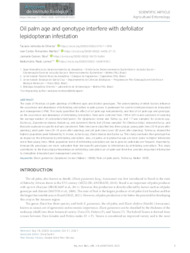Oil palm age and genotype interfere with defoliator lepidopteran infestation.
Oil palm age and genotype interfere with defoliator lepidopteran infestation.
Author(s): OLIVEIRA, T. A. de; MARTINS, I. C. F.; SILVA, J. G.; LEMOS, W. de P.
Summary: The state of Pará has oil palm plantings of different ages and distinct genotypes. The understanding of which factors influence the occurrence and abundance of defoliating caterpillars in palm groves is paramount for control strategies based on integrated pest management (IPM). This study quantified the effect of oil palm age independently, and that of oil palm age and genotype, on the occurrence and abundance of defoliating caterpillars. Data were collected from 1994-2014 and consisted of counting the average number of caterpillars/leaf/parcel. For Opsiphanes invirae and Talima sp., leaf 17 was sampled; for Acharia spp., Euclea sp., Euprosterna elaeasa, Natada sp., and Automeris liberia, leaf 25 was sampled. For Oiketicus kirbyi, Antaeotricha sp., and Brassolis sophorae no specific leaf was considered. Palm trees were classified into three groups: young palm trees (0-8 years after planting), adult palm trees (9-19 years after planting), and old palm trees (over 20 years after planting). Talima sp. showed the highest population peak followed by O. invirae, Acharia spp., Elaeis elaeasa and Euclea sp. This study concludes that genotype has an impact on the infestation by defoliating caterpillars. Also, oil palms at reproductive age are more prone to higher infestation levels than young trees. While population levels of defoliating caterpillars are low in general, outbreaks are frequent. Importantly, intraspecific genotypes are more vulnerable than interspecific genotypes to infestations by defoliating caterpillars. This study contributes to the bioecological knowledge on defoliating caterpillars on oil palm and therefore provides important information to strengthen integrated pest management practices.
Publication year: 2021
Types of publication: Journal article
Unit: Embrapa Eastern Amazon
Keywords: Dendê, Elaeis Guineensis, Opsiphanes invirae, Palma de óleo, Praga de Planta
Observation
Some of Embrapa's publications are published as ePub files. To read them, use or download one of the following free software options to your computer or mobile device. Android: Google Play Books; IOS: iBooks; Windows and Linux: Calibre.
Access other publications
Access the Agricultural Research Database (BDPA) to consult Embrapa's full library collection and records.
Visit Embrapa Bookstore to purchase books and other publications sold by Embrapa.

